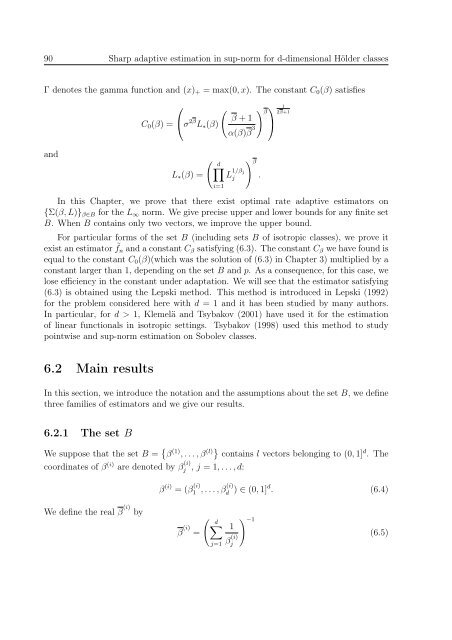THÈSE DE DOCTORAT DE L'UNIVERSITÉ PARIS 6 Spécialité ...
THÈSE DE DOCTORAT DE L'UNIVERSITÉ PARIS 6 Spécialité ...
THÈSE DE DOCTORAT DE L'UNIVERSITÉ PARIS 6 Spécialité ...
- No tags were found...
Create successful ePaper yourself
Turn your PDF publications into a flip-book with our unique Google optimized e-Paper software.
90 Sharp adaptive estimation in sup-norm for d-dimensional Hölder classesΓ denotes the gamma function and (x) + = max(0, x). The constant C 0 (β) satisfiesand⎛C 0 (β) = ⎝σ 2β L ∗ (β)L ∗ (β) =(( d∏i=1) ⎞ ββ + 1⎠α(β)β 3L 1/β jjIn this Chapter, we prove that there exist optimal rate adaptive estimators on{Σ(β, L)} β∈B for the L ∞ norm. We give precise upper and lower bounds for any finite setB. When B contains only two vectors, we improve the upper bound.For particular forms of the set B (including sets B of isotropic classes), we prove itexist an estimator ˜f n and a constant C β satisfying (6.3). The constant C β we have found isequal to the constant C 0 (β)(which was the solution of (6.3) in Chapter 3) multiplied by aconstant larger than 1, depending on the set B and p. As a consequence, for this case, welose efficiency in the constant under adaptation. We will see that the estimator satisfying(6.3) is obtained using the Lepski method. This method is introduced in Lepski (1992)for the problem considered here with d = 1 and it has been studied by many authors.In particular, for d > 1, Klemelä and Tsybakov (2001) have used it for the estimationof linear functionals in isotropic settings. Tsybakov (1998) used this method to studypointwise and sup-norm estimation on Sobolev classes.) β.12β+16.2 Main resultsIn this section, we introduce the notation and the assumptions about the set B, we definethree families of estimators and we give our results.6.2.1 The set BWe suppose that the set B = { β (1) , . . . , β (l)} contains l vectors belonging to (0, 1] d . Thecoordinates of β (i) are denoted by β (i)j , j = 1, . . . , d:β (i) = (β (i)1 , . . . , β (i)d ) ∈ (0, 1]d . (6.4)We define the real β (i) byβ (i) =( d∑j=11β (i)j) −1(6.5)










